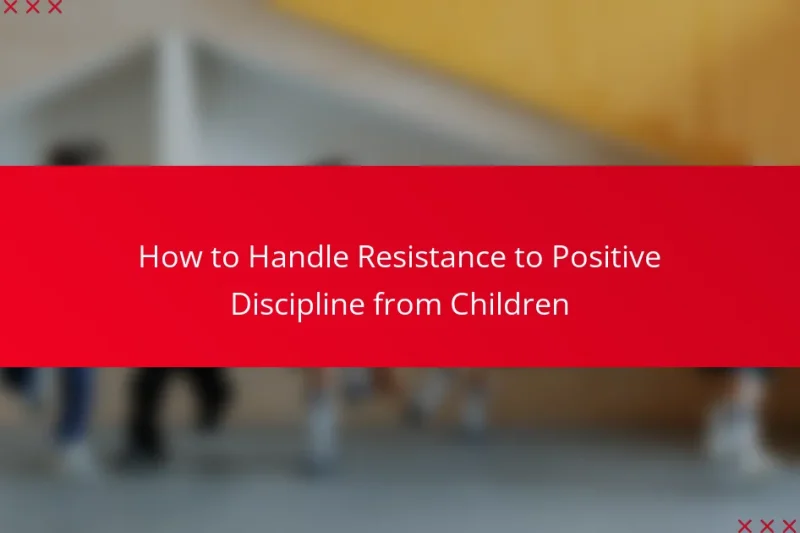Creating a support network for positive discipline practices is essential for enhancing collaboration among caregivers and … Creating a Support Network for Positive Discipline PracticesRead more
Positive Discipline Challenges and Solutions for Parents
Positive discipline is an essential approach for parents aiming to guide their children towards appropriate behavior while fostering a supportive environment. By focusing on effective communication, clear expectations, and emotional regulation, parents can navigate common challenges and enhance their discipline strategies. Tailoring techniques to fit the developmental stages of children ensures that discipline methods are both effective and resonant with their unique needs.
Navigating Conflicts with Other Caregivers using Positive Discipline
Navigating conflicts with other caregivers can be challenging, but employing positive discipline techniques can foster a … Navigating Conflicts with Other Caregivers using Positive DisciplineRead more
Managing Stress as a Parent while Implementing Positive Discipline
Managing stress as a parent is crucial for fostering a healthy family dynamic, especially when implementing … Managing Stress as a Parent while Implementing Positive DisciplineRead more
Dealing with Setbacks in Positive Discipline Approaches
Dealing with setbacks in positive discipline approaches requires a calm and adaptable mindset from parents and … Dealing with Setbacks in Positive Discipline ApproachesRead more
Strategies for Maintaining Consistency in Positive Discipline
Maintaining consistency in positive discipline is essential for fostering a supportive and structured environment for children. … Strategies for Maintaining Consistency in Positive DisciplineRead more
Addressing Common Misconceptions about Positive Discipline
Positive Discipline is often misunderstood, leading to misconceptions that can hinder its effective application in child-rearing. … Addressing Common Misconceptions about Positive DisciplineRead more
How to Handle Resistance to Positive Discipline from Children
Handling resistance to positive discipline requires a thoughtful approach that emphasizes clear communication and emotional intelligence. … How to Handle Resistance to Positive Discipline from ChildrenRead more
What are the effective strategies for positive discipline in parenting?
Effective strategies for positive discipline in parenting focus on fostering a supportive environment while guiding children towards appropriate behavior. These strategies emphasize communication, clear expectations, reinforcement of positive actions, modeling behavior, and understanding natural consequences.
Consistent communication
Consistent communication is vital for positive discipline as it helps children understand expectations and feelings. Regularly discussing rules and consequences ensures that children are aware of what is expected of them and why. Use simple language and encourage open dialogue to foster trust and understanding.
Establish a routine for these discussions, such as weekly family meetings, to reinforce the importance of communication. This consistency helps children feel secure and valued, making them more likely to adhere to guidelines.
Setting clear expectations
Setting clear expectations involves defining specific behaviors you want to encourage or discourage. Clearly articulate rules and the reasons behind them, ensuring children understand the consequences of their actions. For example, instead of saying “be good,” specify “please use your indoor voice when we are at home.”
Visual aids, such as charts or lists, can help reinforce these expectations. Display them in common areas to serve as constant reminders, making it easier for children to remember and follow the rules.
Positive reinforcement techniques
Positive reinforcement techniques involve acknowledging and rewarding desirable behaviors to encourage their recurrence. This can include verbal praise, small rewards, or special privileges when children meet expectations. For instance, if a child completes their homework without reminders, a simple “Great job!” or a sticker can motivate them.
Consider implementing a reward system where children can earn points for positive behaviors that can be exchanged for a treat or activity. This not only reinforces good behavior but also makes discipline a more engaging process.
Modeling appropriate behavior
Modeling appropriate behavior is crucial as children often learn by observing their parents. Demonstrate the behaviors you wish to instill, such as patience, respect, and problem-solving. For example, if you want your child to express their feelings, show them how to do so in a calm and respectful manner.
Engage in role-playing scenarios to practice these behaviors together. This hands-on approach helps children internalize the lessons and understand how to apply them in real-life situations.
Utilizing natural consequences
Utilizing natural consequences means allowing children to experience the results of their actions in a safe environment. This approach teaches responsibility and helps them understand the impact of their choices. For example, if a child refuses to wear a coat on a chilly day, they may feel cold, reinforcing the importance of dressing appropriately.
Ensure that the consequences are age-appropriate and safe. Discuss the outcomes with your child afterward to help them reflect on their choices and learn from their experiences, promoting critical thinking and better decision-making in the future.
How can parents overcome common challenges in positive discipline?
Parents can overcome common challenges in positive discipline by employing effective strategies that promote understanding and cooperation. Focusing on communication, emotional regulation, and consistency can significantly enhance the discipline process.
Managing emotional responses
Managing emotional responses is crucial for parents practicing positive discipline. When emotions run high, both parents and children may react impulsively, which can undermine the discipline effort. Parents should take a moment to breathe and reflect before responding, ensuring they approach the situation calmly.
Using techniques such as deep breathing or counting to ten can help parents regain composure. Additionally, acknowledging a child’s feelings can validate their emotions, making it easier to guide them toward appropriate behavior.
Dealing with resistance from children
Resistance from children is a common challenge in positive discipline, often stemming from a desire for autonomy. Parents can address this by offering choices within set boundaries, which empowers children while maintaining structure. For example, instead of saying, “It’s time to clean your room,” parents might say, “Would you like to clean your room now or after dinner?”
Consistency is key; parents should follow through on consequences while remaining open to discussion. This approach helps children understand the reasons behind rules and encourages compliance over time.
Balancing discipline with affection
Balancing discipline with affection is essential for fostering a healthy parent-child relationship. Positive discipline should not only focus on correcting behavior but also on reinforcing love and support. Parents can express affection through verbal affirmations, hugs, or quality time, even when addressing misbehavior.
Setting aside regular time for positive interactions can help maintain this balance. For instance, after a discipline moment, parents can engage in a fun activity together, reinforcing the idea that love and discipline coexist. This approach helps children feel secure and understood, making them more receptive to guidance.
What role does age play in positive discipline techniques?
Age significantly influences the effectiveness of positive discipline techniques, as children’s developmental stages dictate their understanding and behavior. Tailoring approaches to fit toddlers, school-aged children, and teenagers ensures that discipline methods resonate with their cognitive and emotional capacities.
Strategies for toddlers
For toddlers, positive discipline focuses on setting clear boundaries and using simple language. Techniques such as redirection can be effective; for instance, if a child is reaching for a fragile item, redirect their attention to a safe toy instead.
Consistency is crucial at this age. Parents should reinforce rules with gentle reminders and praise positive behavior. For example, if a toddler shares a toy, acknowledging this behavior with positive reinforcement can encourage them to repeat it.
Approaches for school-aged children
School-aged children benefit from more structured positive discipline strategies, such as logical consequences. For instance, if a child neglects their homework, a natural consequence would be losing privileges related to leisure activities until the work is completed.
Involving children in problem-solving can also be effective. Parents can ask their children how they might handle a situation differently next time, fostering critical thinking and accountability. Regular family meetings can provide a platform for discussing rules and expectations collaboratively.
Methods for teenagers
With teenagers, positive discipline shifts towards fostering independence while maintaining boundaries. Open communication is vital; parents should encourage discussions about decisions and their consequences, helping teens learn from their experiences.
Setting clear expectations and involving teens in the rule-making process can enhance their sense of responsibility. For example, discussing curfew times and the reasons behind them can lead to mutual agreement, making it more likely that the teen will adhere to the rules.
How can parents implement positive discipline in different settings?
Parents can implement positive discipline by using consistent strategies that promote respect, responsibility, and problem-solving across various environments. This approach encourages children to understand the consequences of their actions while fostering a supportive atmosphere.
Positive discipline at home
At home, positive discipline involves setting clear expectations and boundaries while encouraging open communication. Parents can use techniques such as time-outs, natural consequences, and family meetings to address behavioral issues constructively.
For example, if a child refuses to do their homework, a parent might allow them to experience the natural consequence of not being prepared for school. This method teaches responsibility without resorting to punishment.
Positive discipline in schools
In schools, positive discipline focuses on creating a safe and respectful learning environment. Educators can implement strategies like restorative practices, where students reflect on their behavior and its impact on others, fostering empathy and accountability.
Schools may also use behavior charts or reward systems to encourage positive actions. For instance, students can earn points for good behavior, which can be exchanged for privileges, promoting a culture of respect and cooperation.
Positive discipline in public places
When in public places, parents can apply positive discipline by modeling appropriate behavior and setting clear expectations before outings. Discussing rules, such as staying close and using indoor voices, helps children understand acceptable conduct in various settings.
In situations where a child misbehaves, calmly addressing the behavior and explaining why it is inappropriate can be effective. For example, if a child is running in a store, a parent might say, “We walk in stores to keep everyone safe.” This reinforces the importance of safety while maintaining a positive atmosphere.
What are the benefits of positive discipline for children?
Positive discipline offers numerous benefits for children, fostering their development in various areas. It encourages self-discipline, enhances emotional intelligence, and builds resilience, equipping children with essential life skills.
Improved emotional regulation
Positive discipline helps children learn to manage their emotions effectively. By using techniques such as role-playing and guided discussions, parents can teach kids to identify their feelings and express them appropriately. This skill is crucial for reducing instances of anger and frustration.
For example, when a child feels upset, parents can encourage them to take deep breaths or use “I feel” statements to communicate their emotions. Over time, this practice can lead to better emotional control and fewer outbursts.
Enhanced problem-solving skills
Through positive discipline, children develop critical thinking and problem-solving abilities. Instead of simply providing solutions, parents can guide their children to think through challenges and come up with their own answers. This approach fosters independence and confidence.
Parents might present a scenario, such as a conflict with a friend, and ask their child how they would handle it. This encourages children to analyze the situation and consider various outcomes, enhancing their decision-making skills.
Stronger parent-child relationships
Implementing positive discipline strengthens the bond between parents and children. By focusing on mutual respect and open communication, families can create a supportive environment where children feel safe to express themselves. This connection is vital for healthy emotional development.
Regular family meetings can be an effective way to reinforce this relationship. During these meetings, parents and children can discuss rules, expectations, and feelings, ensuring everyone feels heard and valued. This collaborative approach fosters trust and understanding.
What resources are available for parents seeking guidance on positive discipline?
Parents looking for guidance on positive discipline can access a variety of resources, including books, online courses, and community workshops. These tools provide practical strategies and insights to help parents foster a supportive environment while managing their children’s behavior effectively.
Books on positive discipline
Books on positive discipline offer valuable insights and techniques for parents. Notable titles include “Positive Discipline” by Jane Nelsen, which emphasizes understanding children’s needs and fostering cooperation through respectful communication. Another recommended read is “The Whole-Brain Child” by Daniel J. Siegel and Tina Payne Bryson, which integrates neuroscience with parenting strategies.
When selecting books, consider your child’s age and specific challenges. For younger children, look for resources that focus on nurturing emotional intelligence, while books aimed at older kids may address more complex behavioral issues. Many of these books also include practical exercises and real-life examples to help parents apply the concepts.
To maximize the benefits of these books, create a reading schedule that allows for reflection and application of the strategies discussed. Joining a book club or online forum can also enhance understanding through shared experiences and discussions with other parents.






